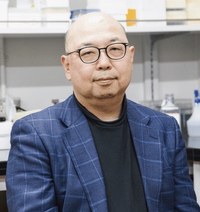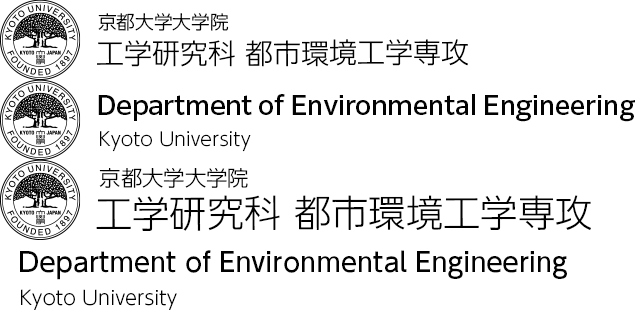Environmental Quality Management
We are investigating the generation mechanism of pollutants with human activity and by nature; and those accumulation, transportation, transformation and fate in the environment and in the ecosystem; and those effects to the biota and the environment using the state-of-the-art analytical methodologies and bio-assays. Our research area is also extended to the development of innovative technologies for controlling and removing these pollutants in the environment. The research concerned with these pollution in Lake Biwa and its watershed have been developed intensively using the special laboratory in the Research Center for Environmental Quality Management, located on the shoreline of the lake.
Academic Staff
Tomonari MATSUDA
 Professor (Graduate School of Engineering)
Professor (Graduate School of Engineering)
Research Topics
Environmental toxicological topics are covered including development of biomarkers by using metabolome and proteome techniques, identification of new toxic chemicals in the environment and elucidation of toxic mechanism.
Contacts
Room 365, Cluster C1-3, Katsura campus
TEL: +81-75-383-3342
E-mail: matsuda.tomonari.8z@kyoto-u.ac.jp
Yasuhiro ASADA
 Associate Professor (Graduate School of Engineering)
Associate Professor (Graduate School of Engineering)
Research Topics
Climate change has caused more serious impact on water environment and water resources, including harmful algal blooms and extreme weather events such as large storms and severe drought. In particular, algal blooms are causing a variety of problems around the world, including the production of toxic and odor substances and serious impact on water treatment. I focus on development of algal researches including algal ecology, molecular phylogenetic analysis, advanced monitoring methods in water environments, treatment technologies.
Contacts
TEL: +81-77-527-6221
FAX: +81-77-527-9869
E-mail: asada.yasuhiro.4z@kyoto-u.ac.jp
https://www.eqc.kyoto-u.ac.jp/management/member/Asada.html
Haruka TAKEUCHI
Assistant Professor (Graduate School of Engineering)
Research Topics
Contacts
Research Topics
Development of Water Quality and Quantity Simulation Model and Cooperation with the Stakeholders for Integrated Lake Watershed Management
With organizing various information of a lake watershed in GIS (Geographical Information System) and predicting the future of the watershed environment in several scenario, we can share these results and information to the related groups and residents, aiming at building a better watershed management system. The outcome prediction will give the future of the watershed environment based on the scenarios, also leads an effective watershed management plan in the administration system of a present "Government" paradigm. On the other hand, the information and experience obtained through the communication and cooperation with the related groups and residents are useful for the purpose of mechanism making of "Governance," the bottom-up approach. The outcome of this research eventually leads to the "Sustainable and Integrated Watershed Management, which connects human activity and the ecosystem with the local community and regional economic. It also leads to a better administration system's being.

Figure 1 Lake Biwa Basin
Characterization of Natural Organic Matter (NOM) in the Aqueous Environment
The Natural Organic Matter (NOM) in the aqueous environment can become a carrier of micro-organic pollutant, which may lead to the suppression of accumulation and toxicity. Through extraction and fractionation, using the sophisticated analytical equipments (e.g., LC/MS/MS, NMR and FTIR, etc.), and considering the origin, transformation in the environment, this research aims at elucidating the chemical structures which can represent NOM. Recently, although the BOD decreases in lakes (in particular, Lake Biwa) by the spread of sewerage treatment in the watershed, the COD tends to increase gradually. The chemical structures of NOM identified by this research also lead to elucidate the cause of these phenomena. Furthermore, it is possible to use the outcome to elucidate the universal function of NOM in the aqueous environments including water and wastewater treatments.

Figure 2 NOM in the aqueous environment
DNA adductome analysis for determination of unknown DNA damages
DNA damage is thought to be related with carcinogenesis and aging. There are many kinds of DNA damage caused by not only exogenous agents such as UV-light, radiation and environmental carcinogens, but also endogenous agents like reactive oxygen, reactive nitrogen and lipid peroxidation products. We developed the sensitive analyzing methods for various DNA damages by using LC/MS/MS which can detect one DNA base modification per 108 bases. We also developed DNA adductome analysis which can detect both known and unknown DNA damages. There should be many important unknown DNA damages in organisms. We will elucidate their chemical structure and biological properties such as mutagenesity and DNA repair pathways.
Development of biomarkers for environmental pollution and identification of new environmental contaminant.
To develop biomarkers for environmental pollution, we try to identify the bio-molecules or proteins which are increased or decreased by exposure of environmental pollutants, by using metabolome- or proteome-approach. In this study, we are using LC/Q-TOF/MS for collecting data and powerful soft wares for extracting the possible biomarkers among thousands of MS peaks. The identified biomarkers are useful not only for the evaluation of environmental pollution but also elucidation of toxic mechanisms. On the other hand, we are using many efforts to identify unknown- environmental pollutants by using HPLC-bioassay method.
